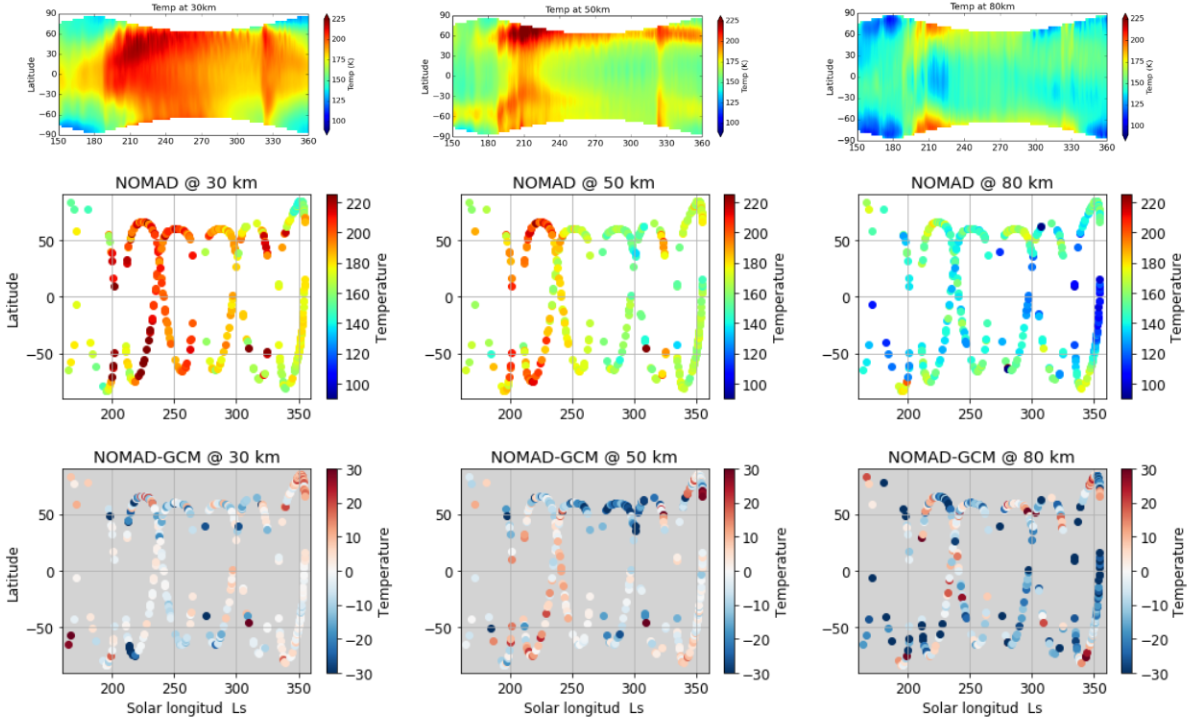JGR (2022); https://doi.org/10.1029/2022JE007278
Miguel-Angel López Valverde, Bernd Funke, Adrian Brines, Aurèlien Stolzenbach, Ashimananda Modak, Brittany Hill, Francisco González-Galindo, Ian Thomas, Loic Trompet, Shohei Aoki, Gerónimo Villanueva, Giuliano Liuzzi, Justin Erwin, Udo Grabowski, Francois Forget, José Juan Lopez Moreno, Julio Rodriguez-Gómez, Bojan Ristic, Frank Daerden, Giancarlo Bellucci, Manish Patel, Ann-Carine Vandaele, the NOMAD team
We present vertical profiles of temperature and density from solar occultation (SO) observations by the “Nadir and Occultation for Mars Discovery” (NOMAD) spectrometer on board the Trace Gas Orbiter (TGO) during its first operational year, which covered the second half of Mars Year 34. We used calibrated transmittance spectra in 380 scans, and apply an in-house pre-processing to clean data systematics. Temperature and CO2 profiles up to about 90 km, with consistent hydrostatic adjustment, are obtained, after adapting an Earth-tested retrieval scheme to Mars conditions. Both pre-processing and retrieval are discussed to illustrate their performance and robustness. Our results reveal the large impact of the MY34 Global Dust Storm (GDS), which warmed the atmosphere at all altitudes. The large GDS aerosols opacity limited the sounding of tropospheric layers. The retrieved temperatures agree well with global climate models (GCM) at tropospheric altitudes, but NOMAD mesospheric temperatures are wavier and globally colder by 10 K in the perihelion season, particularly during the GDS and its decay phase. We observe a warm layer around 80 km during the Southern Spring, especially in the Northern Hemisphere morning terminator, associated to large thermal tides, significantly stronger than in the GCM. Cold mesospheric pockets, close to CO2 condensation temperatures, are more frequently observed than in the GCM. NOMAD CO2 densities show oscillations upon a seasonal trend that track well the latitudinal variations expected. Results uncertainties and suggestions to improve future data re-analysis are briefly discussed.

Temperature latitude-solar longitude cross sections at 3 different altitudes, 30 km (left panels), 50 km (central column’s panels) and 80 km (right-hand panels). The retrieved temperatures are shown in the central row, while Latitude-Ls cross sections from the LMD-MGCM are shown in the top panel, for reference.

